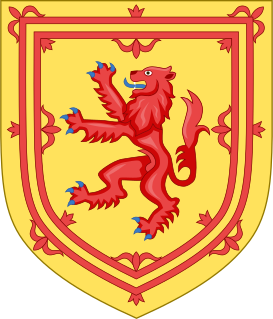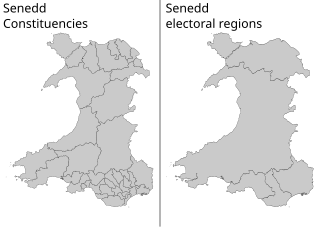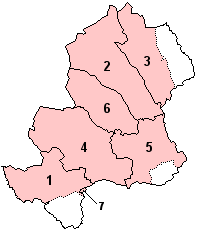The boundary commissions in the United Kingdom are non-departmental public bodies responsible for determining the boundaries of constituencies for elections to the House of Commons. There are four boundary commissions:

Cities of London and Westminster is a constituency returning a single Member of Parliament (MP) to the House of Commons in the United Kingdom Parliament. It is a borough constituency for the purposes of election expenses and type of returning officer. As with all constituencies, the election is decided using the first past the post system of election. Since its creation at the 1950 general election, the constituency has always elected the candidate nominated by the Conservative Party.

As a result of the Fifth Periodical Review of the Boundary Commission for Scotland, Scotland is covered by 59 constituencies of the House of Commons of the United Kingdom Parliament - 19 Burgh constituencies and 40 County constituencies. Constituencies marked * appear on the Central Area Enlargement.

The Parliament of the United Kingdom currently has 650 parliamentary constituencies across the constituent countries, each electing a single member of parliament (MP) to the House of Commons by the plurality voting system, ordinarily every five years. Voting last took place in all 650 of those constituencies at the United Kingdom general election on 12 December 2019.

Scottish Westminster constituencies were Scottish constituencies of the House of Commons of the Parliament of Great Britain, normally at the Palace of Westminster, from 1708 to 1801, and have been constituencies of the House of Commons of the Parliament of the United Kingdom, also at Westminster, since 1801. Constituency boundaries have changed on various occasions, and are now subject to both periodical and ad hoc reviews of the Boundary Commission for Scotland.

The Senedd constituencies and electoral regions are the electoral districts used to elect Members of the Senedd to the Senedd, and have been used in some form since the first election of the then National Assembly for Wales in 1999. New boundaries were introduced for the 2007 elections and currently consist of forty constituencies and five regions. The five electoral regions are: Mid and West Wales, North Wales, South Wales Central, South Wales East, and South Wales West, with the forty constituencies listed below. Voting last took place in all districts in the 2021 Senedd election, and are not used for local government.
The Fifth Periodic Review of Westminster constituencies was undertaken between 2000 and 2007 by the four boundary commissions for England, Scotland, Wales and Northern Ireland for the UK Parliament. The changes for England, Wales and Northern Ireland took effect at the 2010 United Kingdom general election; that for Scotland took effect at the 2005 election. All of the recommendations were approved.

The House of Commons Act 1949 was an Act of the Parliament of the United Kingdom that provided for the periodic review of the number and boundaries of parliamentary constituencies.

The Parliamentary Voting System and Constituencies Act 2011(c. 1) is an Act of the Parliament of the United Kingdom that made provision for the holding of a referendum on whether to introduce the Alternative Vote system in all future general elections to the UK Parliament and also made provision on the number and size of parliamentary constituencies. The Bill for the Act was introduced to the House of Commons on 22 July 2010 and passed third reading on 2 November by 321 votes to 264. The House of Lords passed the Bill, with amendments, on 14 February 2011, and after some compromises between the two Houses on amendments, it received Royal Assent on 16 February.

The Sixth Periodic Review of Westminster constituencies, also known as the 2013 Review, 2018 Review, or just boundary changes, was an ultimately unfruitful cycle of the process by which constituencies of the House of Commons of the United Kingdom are reviewed and redistributed. The four UK boundary commissions carried out their reviews between 2011 and 2018, but their recommendations were not taken up by the government and were formally laid aside in 2020.

The 2023 Periodic Review of Westminster constituencies is the current cycle of the process to redraw the constituency map for the House of Commons. The process for periodic reviews of parliamentary constituencies in the United Kingdom is governed by the Parliamentary Constituencies Act 1986, as amended by the Parliamentary Voting System and Constituencies Act 2011 and subsequently by the Parliamentary Constituencies Act 2020. This review is the successor to the Sixth Periodic Review of Westminster constituencies, which was ultimately abandoned after two successive proposals by the Commissions failed to pass into law.







